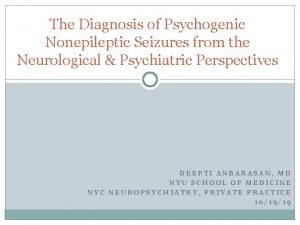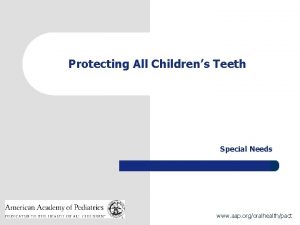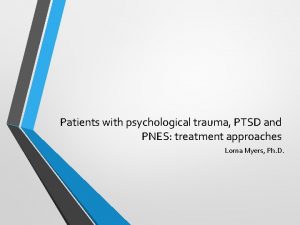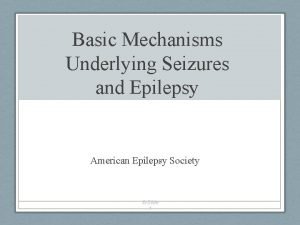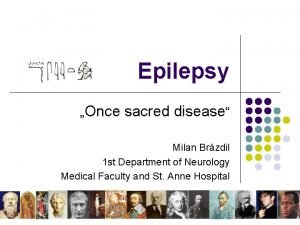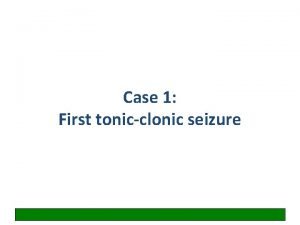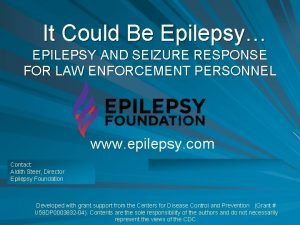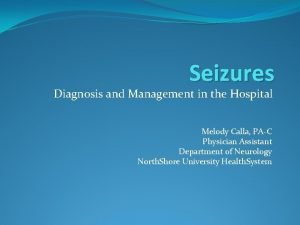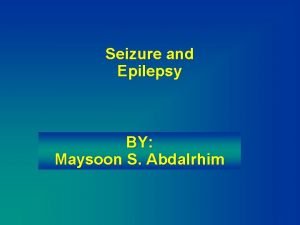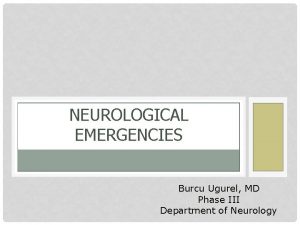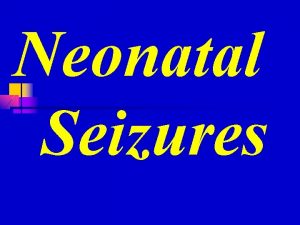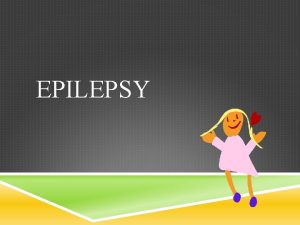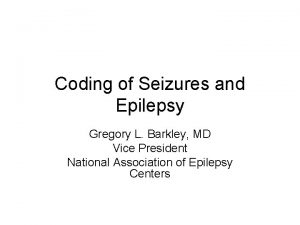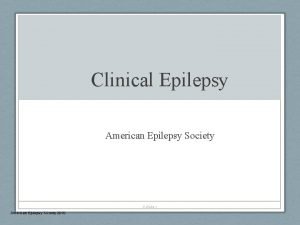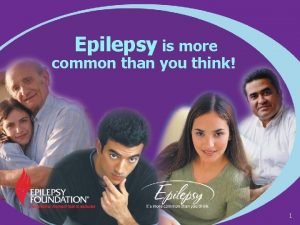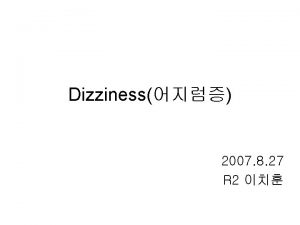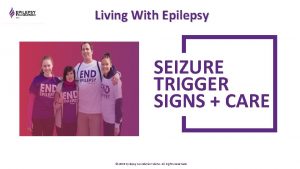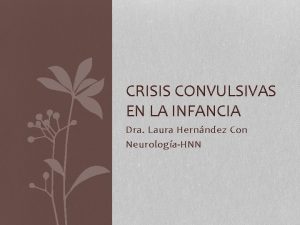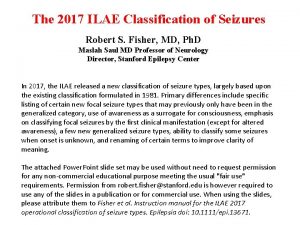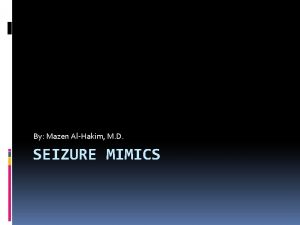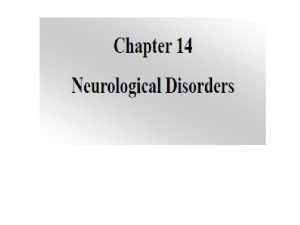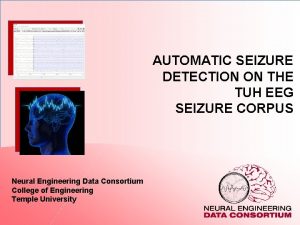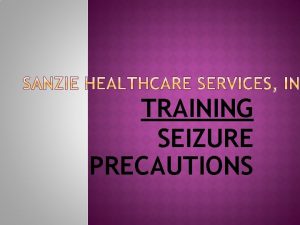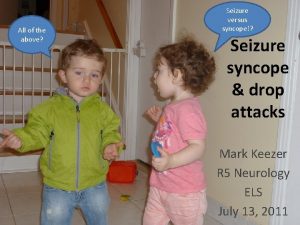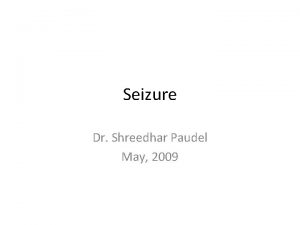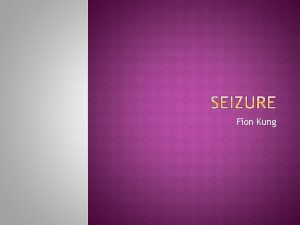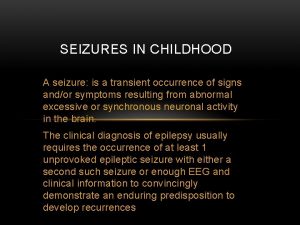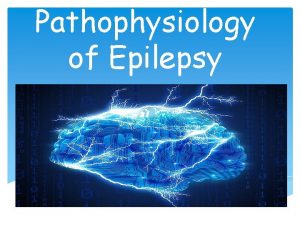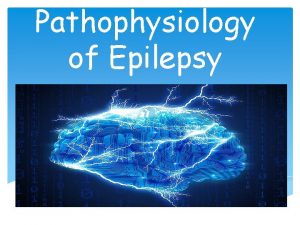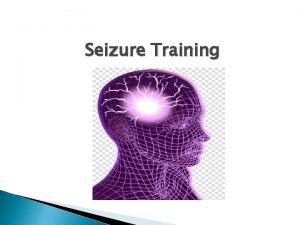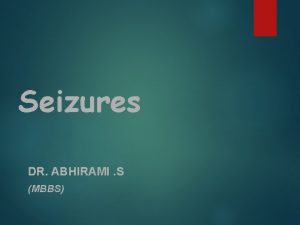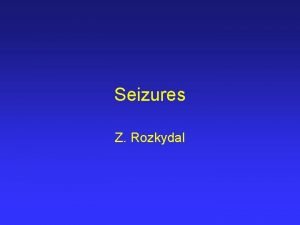Management of Seizures 1 Management of Seizures Seizure







































- Slides: 39

Management of Seizures 1

Management of Seizures Seizure management Introductions House keeping items Washrooms Breaks 2

Learning Objectives Definition of a seizure/epilepsy. Facts about epilepsy. Cause of seizures. Common types and treatments of seizures. Emergency care during a seizure. Documenting a seizure. 5 new facts about seizures that participants can share with school and staff. 3

What is a Seizure? Think Brain! 4

Definition of a Seizure A brief abnormal disturbance of electrical activity of the brain. A seizure may be a brief staring spell, unusual movement of the body or limb, a change in awareness, or a convulsion. 5

What is the difference between a seizure and epilepsy? “I’m not sure!” 6

Seizure versus Epilepsy A seizure may happen in a person due to an illness, fever or a temporary medical condition( i. e. brain tumor). After the illness is treated and resolved the seizure does not happen again. Epilepsy is a ongoing series of seizures. The seizures can occur frequently without a known cause. 7

Seizure versus Epilepsy Many people with epilepsy have different types of seizures that can happen frequently. Having one seizure does not mean you have epilepsy. 8

General Information Most of the people with epilepsy can lead a normal life. Approximately 30, 000 people in Canada have epilepsy. Anyone can development epilepsy at any age. Epilepsy is usually diagnosed in childhood. 9

General Information Seizures can last a few seconds or a few minutes. Seizure may need medical attention if they last too long. People cannot swallow their tongue 10

Causes of Seizures Head trauma: car and sport accidents, falls, blows to the head. Brain tumors and strokes Poisoning: lead poisoning and drug withdrawal Lack of oxygen to the brain for any reason the person can develop seizures. 11

Types of Seizures Partial seizures: seizures that involve part of the brain. Examples are simple partial or complex partial seizures. Most common seizures. Non-convulsive. May spread to the whole brain. Consciousness can be impaired, but not lost. 12

Partial Seizures Simple Partial Seizure: No loss of consciousness. Generally no warning. Person does not lose awareness of environment. Jerking in one part of the body (ie arm/leg). 13

Partial Seizures Complex Partial: Consciousness is impaired. May start with a blank stare. May see altered behavior like picking at clothing, lip smacking or chewing. Person may be unaware of surroundings. 14

Complex Partial Seizures Unresponsive when spoken to. May walk about the room. Seizure may last a few minutes. Will be confused when the seizure is over. No memory of what happened during seizure. 15

Generalized Seizures Seizure affects the whole brain: Person loses consciousness. Can be convulsive or non-convulsive. An aura could occur first. Can be detrimental to the health of a person if continuous. 16

Generalized Seizures Include: Absence Seizures Blank stare, beginning and ending abruptly. Lasts a few seconds. Looks like the child is “day dreaming”. Most common in children. 17

Generalized Seizures Myoclonic Seizures Sudden brief, massive muscle jerks. Parts of /or the whole body may be involved. May fall out of a chair. 18

Generalized Seizures Tonic Clonic Loss of consciousness. Sudden cry Fall to the ground. Stiffening and rhythmic jerking of muscles Altered or shallow breathing. 19

Generalized Seizures May stop breathing temporarily. Skin may turn a bluish color. Possible loss of bowel and bladder. Can last a few minutes. 20

Atonic Seizures (drop attacks) Sudden collapse and fall. May recover after 10 seconds to a minute. 21

Status Epilepticus Any seizure that lasts longer than 30 minutes with or without loss of consciousness. May occur after stopping medications. Can be life threatening if not treated immediately. 22

Treatment for Seizures Medication Surgery Ketogenic Diet Vagal Nerve Stimulator 23

Goals of Treatment Decrease the frequency and severity. Use the smallest amount of drug. Suffer the fewest side effects Improve the quality of life. 24

Medication Most common treatment. Many types of medications available. Side-effect of drugs depend on the drug and person. Epilepsy can be controlled with medications. Common side-effects: 25

Side-Effects of Medications Drowsiness Irritability Nausea Skin rash Visual impairment Hyperactivity 26

Ketogenic Diet High fat, low carbohydrate, low protein. Fluids are restricted. Burns body fat instead of glucose. Must have medical advice and instruction. Risks: low blood sugar and weight loss. Difficult to follow. 27

Surgery Only possible if seizures occur in a small part of the brain. Used as last resort. Cannot be done if speech or memory will be affected. Results vary from partial to full improvement. 28

Vagus Nerve Stimulator Vagus nerve stimulator (VNS) is designed to prevent seizures. Works similar to heart pacemakers. VNS sends mild electrical impulses to the brain by way of the vagus nerve. View following video on next slide re: VNS 29

Vagus Nerve Stimulator http: //www. epilepsy. com/epilepsy/vns 30

Documentation Why do we document seizures? 31

Documentation Assists in the diagnosis and treatment of the disorder. Indicates changes in the pattern or severity of seizures. Help the doctors evaluate the treatment. Alerts the family to events that may cause seizures. 32

Record Date and time of the seizure. Any warning signs prior to the seizure. Describe the body parts involved and the progression. Type of movement (jerky, rhythmic, rigid). Breathing changes and changes in color. 33

Record Loss of consciousness. Behavior after the seizure (i. e. drowsiness, disorientation, recovery time. ) Loss of bladder or bowel control. Who needs to know about the seizure? 34

Management of Seizures 35

Seizure First Aid 36

First Aid Position person, stay, and remain calm Wheelchair or side position only Never put them on their back Never leave a person during a seizure Call for help Protect Person-put something soft under their head Do not restrain move objects out of thrashing range Put nothing in the mouth Loosen restrictive clothing Offer reassurance following seizure 37

Seizure First Aid Record: the seizure time or length Describe the seizure: behavior before during and after the seizure Notify: appropriate people, parents, others Aspiration / choking 38

http: //www. bcepilepsy. com/publications _and_resources/lecture-and-infovideos. aspx 39
 Non epileptic seizures
Non epileptic seizures Pediatric seizures
Pediatric seizures Lorna myers pnes
Lorna myers pnes Classification of anticonvulsant drug
Classification of anticonvulsant drug Basic mechanisms underlying seizures and epilepsy
Basic mechanisms underlying seizures and epilepsy Psychomotor seizures
Psychomotor seizures Psychomotor seizures
Psychomotor seizures Neurocritical care society
Neurocritical care society Nursing management of encephalitis
Nursing management of encephalitis Seizures
Seizures Pimidone
Pimidone Tonic vs clonic
Tonic vs clonic Epilepsy
Epilepsy Complex febrile
Complex febrile Simple partial seizures vs complex
Simple partial seizures vs complex Simple partial seizures vs complex
Simple partial seizures vs complex Sv times hr
Sv times hr Post ictal meaning
Post ictal meaning Syncope vs seizure
Syncope vs seizure Seizure precautions bed rails
Seizure precautions bed rails Hypsarrhythmia eeg
Hypsarrhythmia eeg Ativan status epilepticus
Ativan status epilepticus Porognosis
Porognosis Warning signs of a seizure
Warning signs of a seizure Seizure precautions bed rails
Seizure precautions bed rails Breakthrough seizure
Breakthrough seizure Syncope vs seizure
Syncope vs seizure Rentier state
Rentier state Epilepsy and seizure services near walnut creek
Epilepsy and seizure services near walnut creek Difference between seizure and epilepsy
Difference between seizure and epilepsy Nystagmus mechanism
Nystagmus mechanism Febrile seizure criteria
Febrile seizure criteria Aed medical abbreviation seizure
Aed medical abbreviation seizure Seizure triggers
Seizure triggers Seizure
Seizure Seizure threshold meaning
Seizure threshold meaning Seizure types and symptoms
Seizure types and symptoms What are the 3 main phases of a seizure?
What are the 3 main phases of a seizure? Stages of seizure
Stages of seizure Lateral rectus spikes eeg
Lateral rectus spikes eeg
